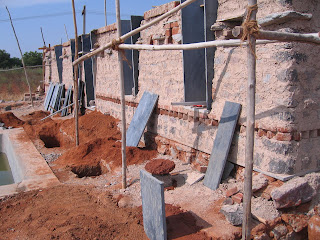
There are still a few days left till the end of the Dastkar show at Kalakshetra, Chennai. Malkha is doing well and could possibly have done better if we had more stock, but we had to keep some in reserve for the Kala Ghoda Festival next month. Here is a picture taken by Hema of Fractal [now called Microspin]
We now have a consultant, Sudheer, volunteering to advise on how to improve the productivity of the malkha centres, and he with our D Srinivas, and Krishna Kumar & Arul from Fractal have begun with Burgula. Krishna Kumar increased the yarn output by 75% a day for the last 2 days, but the reeling is proving to be a bottleneck.
Meanwhile the building of the new malkha centre is going on with the few hands that are available. Among the helpers there are 2 or 3 who are working well and one who is outstanding. We have lost skilled carpenters who have been offered work abroad by agents who are constantly on the look-out in the villages. However, one who had taken up such an offer has now returned.
Sadly local building skills have eroded significantly. Masons and helpers alike have got used to using trowels for cement rather than for mud building, so they smear the mud onto the walls with no regard for keeping the stone parts clean. Golak has devised frames and instructed in plumb line use to ensure that vertical lines are straight and proper leveling of horizontals.
The walls have reached last brick level at 8 foot height and we are now ready for the roof and door & window frames. Bureaucratic hurdles have delayed the sawing of teakwood which will take another week. The building even at this stage looks quite magnificent, with slightly outward canted stone walls. Golak is introducing wooden brackets shaped in local traditional styles which will support the tiled roof. The logic of the building is to ensure that there is plenty of light and air. There is an open courtyard in the centre as found in local traditional houses. There are also elements introduced from other regions, like the upward swing of the roof-ends as in North East India.
Golak, Sivanandan & Sula joined us - Sarita, Usman, Suri Babu, Bhanu & me in Elantakunta on 21st.




